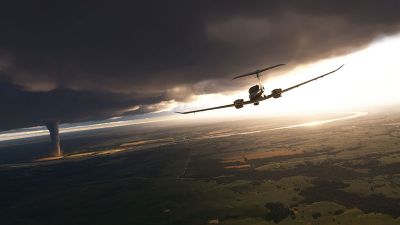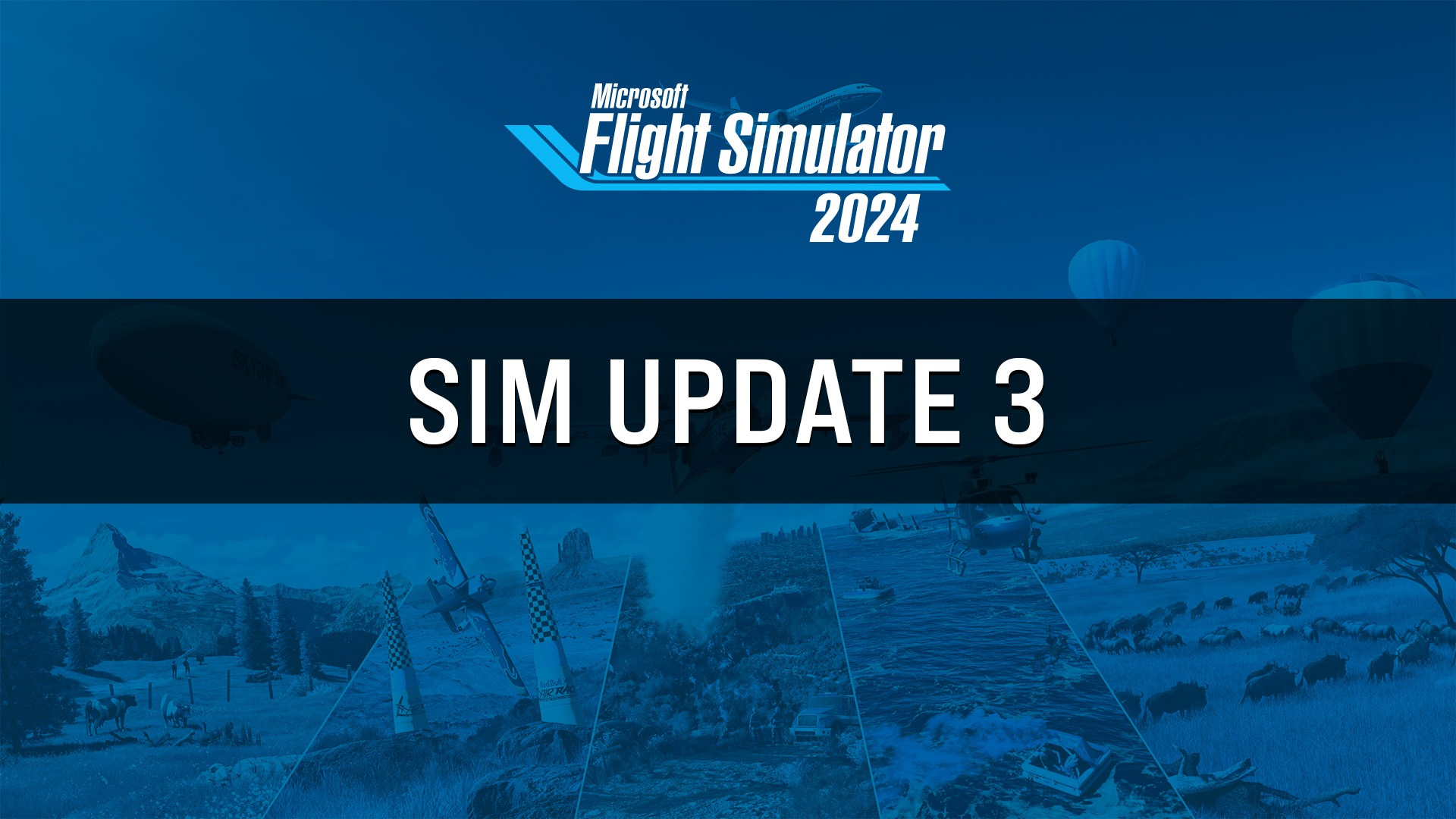
Microsoft Flight Simulator 2024: A Detailed Analysis
The all-new Microsoft Flight Simulator 2024 represents a substantial leap forward in real-time flight simulation, integrating cutting-edge…

This wide-ranging update for Microsoft Flight Simulator 2024 improves performance and stability across the board, with faster load times, fewer crashes, and better aircraft systems. Avionics get more consistent navigation logic, while revised ATC flows enable real-world procedure fidelity. A new level-of-detail curve reduces pop-in, and VR optimizations enhance smoothness. Upgraded AI traffic, an improved EFB, and enriched developer tools further elevate the sim’s overall realism and convenience.

Fifteen days after Sim Update 16 for MSFS 2020, Microsoft has shipped Sim Update 3 for Microsoft Flight Simulator 2024. This release is broad and technical in scope: faster boot and load times, reduced crashes, dozens of aircraft fixes, a major round of avionics and ATC improvements, and deep changes to AI traffic and world scenery fidelity. It is the kind of platform update that quietly unlocks quality-of-life improvements you feel on your first flight.
Before updating: if you see new crashes or sluggish load times on PC, temporarily move any third-party addons out of your Community folder and relaunch. The sim also resets an invalid content.xml automatically, and that file has moved to a new location to avoid multi-account conflicts on the same machine.
Full official notes are available on the Microsoft Flight Simulator site: Sim Update 3 – 1.5.27.0.
On the platform side, SU3 tightens up crash scenarios across boot, VR entry/exit, airport rendering, and model behavior loading. It also fixes a long-standing WASM live view leak that could inflate VRAM across session restarts, and corrects a texture sampling bug that corrupted WASM gauges on Series S or PC when using low texture resolution.
Loading is snappier. Boot and content thumbnail generation are optimized, and the controls menu now caches device profiles to avoid unnecessary file reads. On the graphics front:
For users, that LOD change reduces aggressive pop-in and preserves small-detail geometry better. For developers, it gives headroom to simplify mid/low LODs while maintaining perceived detail—particularly helpful on dense airports and ground vehicles where vertex counts compound quickly. In VR, SU3 re-activates the new LOD curve, removes unnecessary draw calls, and addresses a “wild culling” issue that hit render thread performance. Expect smoother headroom on busy flight decks.
Across avionics stacks (G1000 NXi, G3000/5000, G3X, GNS 430/530, Pro Line 21, Primus Epic 2.0, UNS-1EW), SU3 aligns the navigation algorithms:
Notably, Primus Epic 2.0 gets a full Ground Proximity Warning System suite, including enhanced forward-looking terrain alerts and mode inhibits. The G1000 NXi and Pro Line 21 reduce PFD memory usage. The net impact is fewer edge-case path glitches when you load real-world SIDs/STARs, and steadier capture on final—even on shorter ILSes where noise and slope angles challenged the AP before.
Beyond avionics, the core sim adds support for multiple physics-based ball indicators (coordinated turn “ball”) configurable per aircraft, corrects water rudder control logic, and refines drift damage so tires don’t “wear out” during normal taxi yet still take a hit on fast, high-slip landings.
SU3 brings a long list of ATC changes that, in aggregate, meaningfully improve IFR gate-to-gate:
Crucially, MSFS 2024’s ATC now reflects procedure-driven operations more often. That matters for immersion but also for workload: fewer “gotchas” late in the arrival when clearances previously desynced from what you filed. Radio effects processing also got a pass, and a small but welcome change—altitudes no longer include the spoken “feet” suffix.
Live traffic now forces model matching to AI-optimized assets (with a documented fallback ladder), which reduces stutters when zooming the world map and lowers VRAM spikes at hubs. Parked traffic and airline distribution logic improve regional realism, and multiple taxi logic tweaks discourage “rear-end” collisions and overshooting exits. Some of these are called out as partial, so consider this an iterative pass—better flows, not perfection.
The default EFB receives a substantial quality update:
These are the kind of details that reduce preflight friction. The combination of improved procedure logic and better UI centering prevents a lot of needless back-and-forth when building routes, especially VFR with overlays where “DCT” to custom fixes is now represented more cleanly.
Dozens of aircraft received fixes. A few standouts:
At the platform level, the entire fleet benefits from more realistic hot-start temperatures (oil temp, EGT, CHT) when spawning with engines running. New dedicated keybinds for PARKING_BRAKES_ON and OFF add granularity, and a “Freelance” livery tag helps filter aircraft in career mode. Belly-landing contact points were corrected on several models to stop sideways slides.
Finally, aircraft now interact with tornadoes aerodynamically—an edge case, yes, but good to see the physics envelope widened rather than constrained.
SU3 resolves several VR controller conflicts (rudder vs zoom/scroll), adds touchscreen interactions for avionics and EFB panels, and provides left-handed presets by default. The “look around with mouse” mode can now keep aircraft controls live while you pan, which eases handoffs during critical phases. For gamepad users, new touchscreen binds mean you no longer need “cursor mode” to tap glass.
Career mode gets smarter filters for aircraft specialization, clearer incompatible-aircraft messaging, and a change that disables skip-cruise when the aircraft is damaged or short on fuel. Taxi-to-gate infringement logic has been revised; multiple dialog sets were added for rotorcraft cargo, ag ops, and SAR missions. Mission logic and back-on-track behavior are more robust, and taxi flows for VTOL, helos, and electric types were corrected. The sim also removes the hypoxia failure from activities to avoid false failures on unpressurized types.
The weather engine corrects a regression that caused some airports to ignore METAR, reduces lightning rates to realistic levels, and improves thunderstorm prediction. On the world side, blurry airport-adjacent tiles and photogrammetry tile popping got attention; cloud shape and distant lighting are improved, and previously barren areas (e.g., parts of Amazonia) regain vegetation.
Airports: 188 identifier changes and 368 deletions of closed/non-existent fields are in, alongside dozens of bespoke fixes by Gaya across major hubs (KJFK, KLAX, EGLL, EHAM, KDEN, KATL, KORD, and more) focused on LOD, collisions, elevation/terraforming, and performance. Default airports see numerous micro-fixes, plus better MSFS2020 package compatibility. Microsoft’s airport/helipad tracker reference is included in the notes: Airport/Helipad Issue Tracker.
There’s a lot here for creators. Highlights:
SU3 feels like a consolidation pass that reduces “paper cuts.” The avionics alignment around leg vectorization, flyover support, and glideslope stability is a foundational change—it removes class of bugs that cascade into every complex arrival. The ATC improvements are equally meaningful. We’re not at full real-world procedure nuance yet, but inclusion of STARs, better initial altitude logic, and tighter clearance flows are real progress.
I’m also encouraged by the EFB work. Good flight planning UX lives in the guardrails: smarter procedure filtering, altitude selection that respects airframe limits, and map centering. That reduces setup time and lowers the chance of injecting bad data into avionics. On performance, the LOD curve change plus VR render-thread optimizations are the right direction—more fidelity where it matters visually without paying a heavy cost at hub airports.
Caveats? AI taxi remains iterative (still tagged “partial” in places), and any time the platform shifts LOD behavior, some third-party scenery may need a tune. But the SDK and exporter updates are clearly aligned with those changes.
The official notes go deep—aircraft-by-aircraft, system-by-system. You can browse the entire list on the Microsoft Flight Simulator site: Sim Update 3 – 1.5.27.0.
How are the ATC STAR additions working for you on busy arrivals? If you fly the MAX or 787-10, do the RTE/WIND uplinks change your preflight flow? PC-12 NGX pilots—does the new pressurization/EPS logic match your expectations? And for VR, did the LOD and interaction changes move the needle on smoothness? Share your results and settings in the comments below so others can compare notes.
Upgrade Microsoft Flight Simulator, FSX, P3D & X-Plane in minutes with our curated file library packed with aircraft, scenery, liveries, and utilities.
Ready to upgrade your hangar?
Browse the free file library
0 comments
Leave a Response